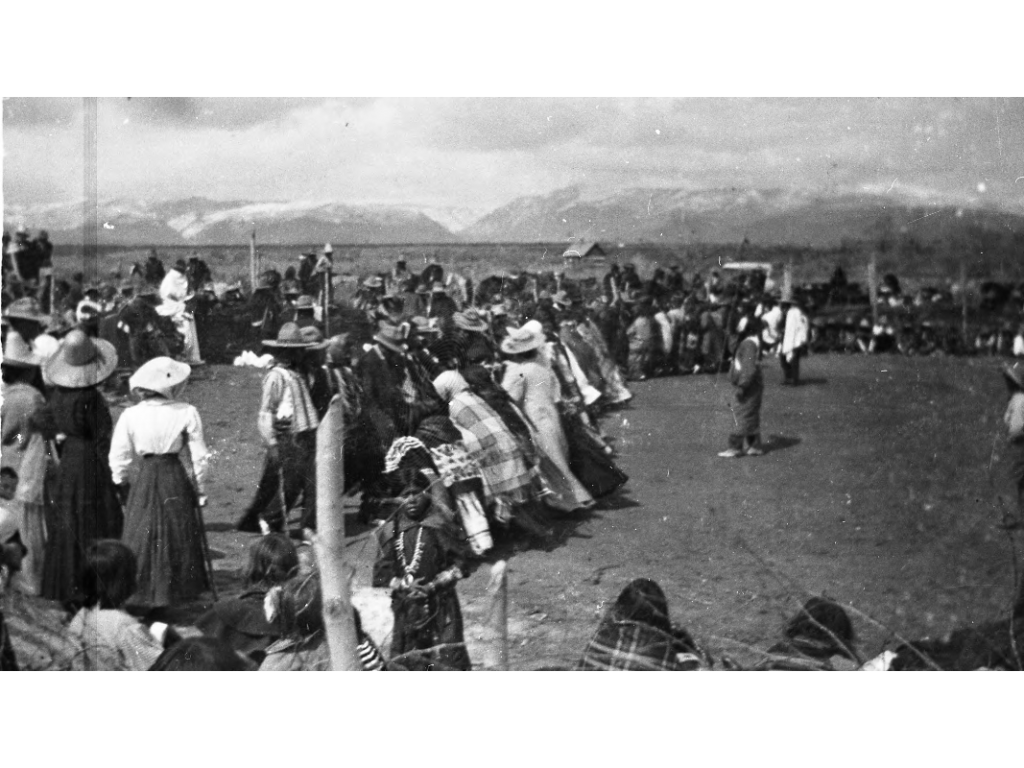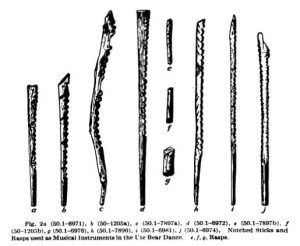Initially, I hoped to research the topic of symbolism in relation to Native American instruments, but that line of researching did not take me far, so I instead settled on looking at the scholarship on their instruments in general. In Clark Wissler’s informational text, The American Indian, there is a section on Native American music which turns to musical instruments, claiming that the two most common instruments are drums and rattles. His survey meanders across the Americas, discussing the cultural varieties of such instruments, emphasizing the dominance of calabash (gourd) rattles, the importance of which, he claims, is only approached by the notched stick1. The footnote attached to this observation, citing anthropologist Robert Lowie, led to where my research ultimately landed.
Lowie has a fair number of entries in another collection of anthropological papers on Native American societies edited by Wissler, one of which examines the “Dances and

Ute Musicians. From left to right: Brookus Sibello 1890, Dick Sibello 1882, Henry Myore, and two young boys. Using notched rasps and rubbing sticks, for music.
Societies of the Plains Shoshone,” within which he describes the Bear Dance, a prominent Ute ceremony. Although he has never seen a Bear Dance himself, Lowie draws upon several first hand accounts of the ceremony to explain the basic function and structure of Bear Dances: a social event lasting four days at the end of winter/beginning of spring in a circular enclosure of branches, where men and women form two lines designated by sex and the women approach whichever men they want to dance with, and the dancing commences2. Watch this video of a Southern Ute Indian tribe Bear Dance, recorded in 1988, to get a better idea. The music produced in the Bear Dance is what brought me to the ceremony, as the principle instrument used in the ceremony, besides singing, is the notched stick (or rattle) mentioned in The American Indian.

Ute Indians perform the Bear Dance on at the Bear Dance Festival. The Bear Dance welcomes the Spring of the year. (1920)
The notched stick, pictured at right, has two parts. The first is a stick about a foot or

Notched sticks and rasps used in Ute Bear Dances (Lowie)
more in length and “throughout its entire length it is whittled flat, and transverse notches or grooves are cut across this flattened portion.”3 The second part is a “rasp”, usually either a bone or rod. The notched stick is held against the ground or similar surface in one hand, while the other holds the rod and “is moved rapidly up and down the grooved portion so as to make a rattling sound.”4 Multiple sets of these are played alongside vocals, setting the dance into motion.
But why is it called the Bear Dance? According to Verner Reed, who in 1893 was invited to a Bear Dance by a Southern Ute tribe in Colorado (one of the first hand accounts Lowie cites), the Ute people “believe their primal ancestors were bears; after these came the race of Indians, who, on dying, were changed to bears” and the Bear Dances are meant to reinforce their friendship. The ceremony is held around the time bears awaken from hibernation and the dance is supposed to “cast the film of blindness from their eyes” when the bears wake.5
